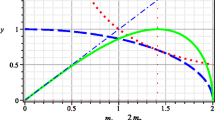Abstract
We present two examples of non-Hermitian Hamiltonians which consist of an unperturbed part plus a perturbation that behaves like a vector, in the framework of \(\mathcal {PT}\) quantum mechanics. The first example is a generalization of the recent work by Bender and Kalveks, wherein the E2 algebra was examined; here we consider the E3 algebra representing a particle on a sphere, and identify the critical value of coupling constant which marks the transition from real to imaginary eigenvalues. Next we analyze a model with SO(3) symmetry, and in the process extend the application of the Wigner-Eckart theorem to a non-Hermitian setting.


Similar content being viewed by others
References
Bender, C.M., Boettcher, S.: Real spectra in non-Hermitian Hamiltonians having PT symmetry. Phys. Rev. Lett. 80, 5243–5246 (1998)
Bender, C.M., Boettcher, S., Meisinger, P.: PT symmetric quantum mechanics. J. Math. Phys. 40, 2201–2229 (1999)
Bender, C.M.: Making sense of non-Hermitian Hamiltonians. Rep. Prog. Phys. 70, 947 (2007)
Guo, A., Salamo, G.J., Duchesne, D., Morandotti, R., Volatier-Ravat, M., Aimez, V., Siviloglou, G.A., Christodoulides, D.N.: Observation of \(\mathcal{P}\mathcal{T}\)-symmetry breaking in complex optical potentials. Phys. Rev. Lett. 103, 093902 (2009)
Ruter, C.E., Makris, K.G., El-Ganainy, R., Christodoulides, D.N., Segev, M., Kip, D.: Observation of parity-time symmetry in optics. Nat. Phys. 6, 1515 (2010)
Zhao, K.F., Schaden, M., Wu, Z.: Enhanced magnetic resonance signal of spin-polarized Rb atoms near surfaces of coated cells. Phys. Rev. A 81, 042903 (2010)
Bender, C., Kalveks, R.: \(\mathcal{PT}\) symmetry from Heisenberg algebra to E2 algebra. Int. J. Theor. Phys. 50, 955–962 (2011)
Coleman, S., Jackiw, R., Politzer, H.D.: Phys. Rev. D 10, 2491 (1974)
Acknowledgements
The authors would like to thank Harsh Mathur and Carl Bender for useful conversations.
Author information
Authors and Affiliations
Corresponding author
Appendix: Wigner-Eckart Theorem
Appendix: Wigner-Eckart Theorem
Suppose we have an angular momentum operator L and a vector operator V satisfying the commutation relations
Let |ℓ,m〉 denote an angular momentum multiplet of total angular momentum ℓ and z-component m. Then according to the Wigner-Eckart theorem the matrix elements of V z and V ±=V x ±iV y between multiplet states are determined by the commutation relations Eq. (34). In the usual Wigner-Eckart theorem the Cartesian components of the operator V are assumed to be hermitian. Here we present a non-Hermitian generalization of the theorem.
Following the usual arguments we find the selection rules



Furthermore the matrix elements vanish unless ℓ′=ℓ−1 or ℓ′=ℓ or ℓ′=ℓ+1.
Consider the case ℓ′=ℓ. Generalization of the usual arguments shows that

where the proportionality constant A is a complex number called the “reduced matrix element”. Note that for V hermitian, A would have to be real, but there is no such restriction in the non-hermitian case.
Similarly in the case ℓ′=ℓ+1 we find
where m=−ℓ,…,ℓ and B is another complex reduced matrix element.
Finally in the case that ℓ′=ℓ−1 we find
where C is a complex reduced matrix element and m=−ℓ,…,ℓ−2 in the first line of Eq. (40), m=−ℓ+1,…,ℓ−1 in the second line of Eq. (40), and m=−ℓ+2,…,ℓ in the last line of Eq. (40).
In the hermitian case the reduced matrix elements satisfy B=C ∗ but in the non-hermitian case there is no such restriction on the complex elements B and C.
Rights and permissions
About this article
Cite this article
Jones-Smith, K., Kalveks, R. Vector Models in \(\mathcal{PT}\) Quantum Mechanics. Int J Theor Phys 52, 2187–2195 (2013). https://doi.org/10.1007/s10773-013-1493-7
Received:
Accepted:
Published:
Issue Date:
DOI: https://doi.org/10.1007/s10773-013-1493-7



